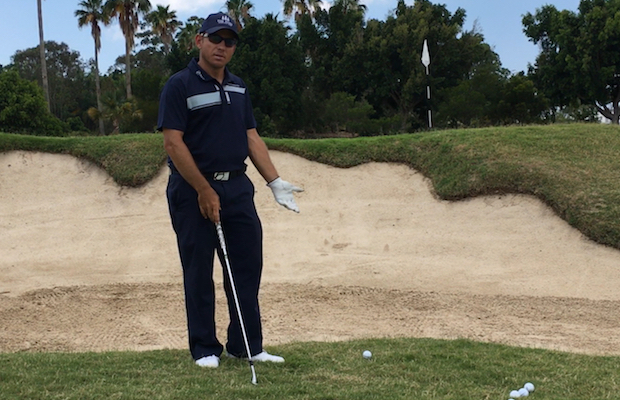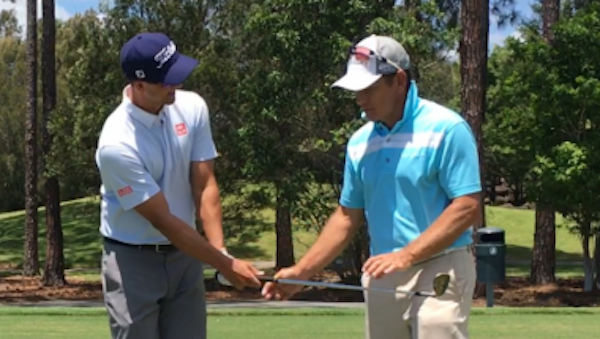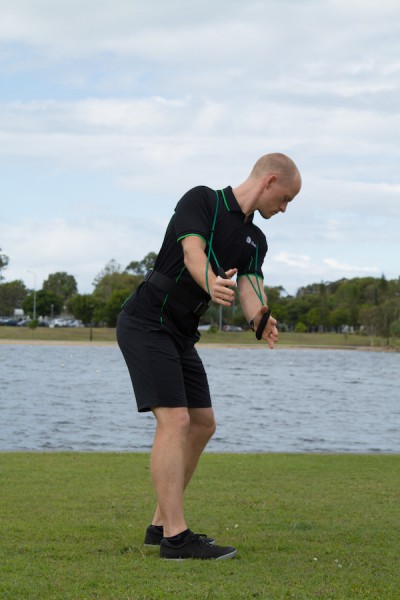Instruction
Build A More Consistent Short Game Through Better Body Movement

So far in my collection of articles on GolfWRX, I’ve talked at length about the importance of posture, stability and movement patterns in the full swing, particularly utilizing the GravityFit equipment for feedback and training load. Many coaches use the same equipment to teach better movement in the putting, chipping, and pitching actions.
To help give some more insight into exactly how they do this, I have recruited Matt Ballard to co-author this article. Matt is an Australian-based coach and short game specialist who has been working with Adam Scott for the past year.
According to Matt, the short game issue that the club players he coaches struggle with is contact and delivering consistent loft with their wedges.
“Most people tend to get steep, the handle comes in first and not enough loft is delivered,” he says. “This means that the bounce of the wedge isn’t being used properly, which makes control of contact, trajectory, and distance very difficult. ”
As Matt explains in the video below, this problem tends to manifest itself in chips and pitches that are either fat or thin, fly to short or not far enough, and either check up too soon or go rolling on past the pin.
The really frustrating part is the inconsistency. Not knowing how the ball is going to react makes committing to a shot extremely difficult. This has the unnerving effect of turning a simple task into something difficult… and pars into bogeys or worse. For the past few months, Matt has been using the GravityFit TPro to teach correct set up posture and body movement for chipping and pitching.
“I use the TPro to first of all establish spine and shoulder position,” Matt says. “I like my students to have the feel of their shoulders and forearms being externally rotated (turned out). From this position, it’s much easier to control the clubface (i.e. not getting it too shut or too open). The second benefit of using the TPro is controlling the golf club radius during the swing, with the radius being the distance the club head is from the center of the body. Controlling the radius is paramount to becoming an excellent wedge player. The third reason I use it is to help teach that pure rotation from the thoracic spine (mid/upper back), minimizing the excessive right side bend (for a right handed player) that gets so many people into trouble.”
Essentially, Matt uses the GravityFit TPro to train a simple movement pattern that, once mastered, all but eliminate the typical problems normally associated with chipping and pitching.
“When (golfers) learn to turn using their thoracic spine and keep their arms in front of their body, it has a dramatic effect on how they deliver the club to the ball,” Matt says. “They are now able to maintain width or radius on either side of the ball, shallow out the club, and engage the bounce (sole) of the wedge to interact with the turf effectively, which is a key trait of all excellent wedge players. Doing this greatly increases their margin for error from a strike perspective and produces a far more consistent outcome in terms of loft, trajectory and distance control.”
Here is Matt’s 5-step process that you can follow with the TPro:
- Push handles out in front of your body, keeping slight bend in elbow.
- Stretch tall. Feel the green spikes in your middle/upper back and your shoulder blades on the paddles.
- Hinge forward into posture for pitching or chipping (the shorter the shot, narrower the stance.).
- Slowly turn chest into backswing, keep arms out in front of body, and maintain pressure on the spikes and paddles.
- Turn through to finish position using normal tempo, maintaining same pressure on the TPro and keeping arms in front of your body.
In summary, using the TPro and Matt’s drill can help you train a simple movement pattern that can give you far more control over the strike, trajectory and distance of your chips and pitches.
Click here to learn more about the TPro. To discover more pearls of wisdom from Matt, take a look at his website here and his social media activity here.
- LIKE7
- LEGIT2
- WOW0
- LOL0
- IDHT0
- FLOP1
- OB0
- SHANK13
Instruction
Clement: Laid-off or perfect fade? Across-the-line or perfect draw?

Some call the image on the left laid off, but if you are hitting a fade, this could be a perfect backswing for it! Same for across the line for a draw! Stop racking your brain with perceived mistakes and simply match backswing to shot shape!
- LIKE0
- LEGIT0
- WOW0
- LOL0
- IDHT0
- FLOP0
- OB0
- SHANK1
Instruction
The Wedge Guy: The easiest-to-learn golf basic

My golf learning began with this simple fact – if you don’t have a fundamentally sound hold on the golf club, it is practically impossible for your body to execute a fundamentally sound golf swing. I’m still a big believer that the golf swing is much easier to execute if you begin with the proper hold on the club.
As you might imagine, I come into contact with hundreds of golfers of all skill levels. And it is very rare to see a good player with a bad hold on the golf club. There are some exceptions, for sure, but they are very few and very far between, and they typically have beat so many balls with their poor grip that they’ve found a way to work around it.
The reality of biophysics is that the body moves only in certain ways – and the particulars of the way you hold the golf club can totally prevent a sound swing motion that allows the club to release properly through the impact zone. The wonderful thing is that anyone can learn how to put a fundamentally sound hold on the golf club, and you can practice it anywhere your hands are not otherwise engaged, like watching TV or just sitting and relaxing.
Whether you prefer an overlap, interlock or full-finger (not baseball!) grip on the club, the same fundamentals apply. Here are the major grip faults I see most often, in the order of the frequency:
Mis-aligned hands
By this I mean that the palms of the two hands are not parallel to each other. Too many golfers have a weak left hand and strong right, or vice versa. The easiest way to learn how to hold the club with your palms aligned properly is to grip a plain wooden ruler or yardstick. It forces the hands to align properly and shows you how that feels. If you grip and re-grip a yardstick several times, then grip a club, you’ll see that the learning curve is almost immediate.
The position of the grip in the upper/left hand
I also observe many golfers who have the butt of the grip too far into the heel pad of the upper hand (the left hand for right-handed players). It’s amazing how much easier it is to release the club through the ball if even 1/4-1/2″ of the butt is beyond the left heel pad. Try this yourself to see what I mean. Swing the club freely with just your left hand and notice the difference in its release from when you hold it at the end of the grip, versus gripping down even a half inch.
To help you really understand how this works, go to the range and hit shots with your five-iron gripped down a full inch to make the club the same length as your seven-iron. You will probably see an amazing shot shape difference, and likely not see as much distance loss as you would expect.
Too much lower (right) hand on the club
It seems like almost all golfers of 8-10 handicap or higher have the club too far into the palm of the lower hand, because that feels “good” if you are trying to control the path of the clubhead to the ball. But the golf swing is not an effort to hit at the ball – it is a swing of the club. The proper hold on the club has the grip underneath the pad at the base of the fingers. This will likely feel “weak” to you — like you cannot control the club like that. EXACTLY. You should not be trying to control the club with your lower/master hand.
Gripping too tightly
Nearly all golfers hold the club too tightly, which tenses up the forearms and prevents a proper release of the club through impact. In order for the club to move back and through properly, you must feel that the club is controlled by the last three fingers of the upper hand, and the middle two fingers of the lower hand. If you engage your thumbs and forefingers in “holding” the club, the result will almost always be a grip that is too tight. Try this for yourself. Hold the club in your upper hand only, and squeeze firmly with just the last three fingers, with the forefinger and thumb off the club entirely. You have good control, but your forearms are not tense. Then begin to squeeze down with your thumb and forefinger and observe the tensing of the entire forearm. This is the way we are made, so the key to preventing tenseness in the arms is to hold the club very lightly with the “pinchers” — the thumbs and forefingers.
So, those are what I believe are the four fundamentals of a good grip. Anyone can learn them in their home or office very quickly. There is no easier way to improve your ball striking consistency and add distance than giving more attention to the way you hold the golf club.
More from the Wedge Guy
- The Wedge Guy: Golf mastery begins with your wedge game
- The Wedge Guy: Why golf is 20 times harder than brain surgery
- The Wedge Guy: Musings on the golf ball rollback
- LIKE88
- LEGIT14
- WOW6
- LOL1
- IDHT0
- FLOP4
- OB1
- SHANK8
Instruction
Clement: Stop ripping off your swing with this drill!

Not the dreaded headcover under the armpit drill! As if your body is defective and can’t function by itself! Have you seen how incredible the human machine is with all the incredible feats of agility all kinds of athletes are accomplishing? You think your body is so defective (the good Lord is laughing his head off at you) that it needs a headcover tucked under the armpit so you can swing like T-Rex?
- LIKE0
- LEGIT3
- WOW2
- LOL0
- IDHT0
- FLOP0
- OB0
- SHANK2
-

 19th Hole2 weeks ago
19th Hole2 weeks agoJustin Thomas on the equipment choice of Scottie Scheffler that he thinks is ‘weird’
-

 19th Hole2 weeks ago
19th Hole2 weeks ago‘Absolutely crazy’ – Major champ lays into Patrick Cantlay over his decision on final hole of RBC Heritage
-

 19th Hole3 weeks ago
19th Hole3 weeks agoTwo star names reportedly blanked Jon Rahm all week at the Masters
-

 19th Hole3 weeks ago
19th Hole3 weeks agoReport: LIV Golf identifies latest star name they hope to sign to breakaway tour
-

 19th Hole3 weeks ago
19th Hole3 weeks agoNeal Shipley presser ends in awkward fashion after reporter claims Tiger handed him note on 8th fairway
-

 19th Hole2 weeks ago
19th Hole2 weeks agoBrandel Chamblee has ‘no doubt’ who started the McIlroy/LIV rumor and why
-

 19th Hole1 week ago
19th Hole1 week agoLET pro gives detailed financial breakdown of first week on tour…and the net result may shock you
-

 Equipment3 weeks ago
Equipment3 weeks agoJason Day on his recent switch into Srixon ZX5 and ZX7 Mk II irons




















